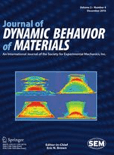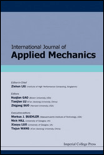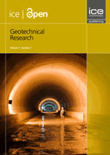
INTERNATIONAL JOURNAL OF IMPACT ENGINEERING
Scope & Guideline
Advancing engineering through impactful research.
Introduction
Aims and Scopes
- Impact Mechanics and Material Behavior:
The journal emphasizes research on the mechanics of impact, including the dynamic response of materials under various loading conditions. This includes studies on strain rate sensitivity, fracture mechanisms, and the energy absorption capabilities of materials. - Numerical and Experimental Investigations:
There is a strong focus on both numerical simulations and experimental studies. Researchers utilize advanced computational techniques, such as finite element analysis and peridynamics, alongside experimental setups like the Split Hopkinson Pressure Bar (SHPB) to validate their models. - Innovative Materials and Structures:
The journal showcases cutting-edge research on novel materials and composite structures designed for improved impact resistance. Topics include auxetic materials, high-performance concrete, and advanced composites that exhibit enhanced energy absorption and damage tolerance. - Blast Resistance and Protective Systems:
Research on blast effects and protective systems is a core area of focus. This includes the evaluation of structures subjected to explosive loads, optimization of protective measures, and the development of new materials designed to mitigate impact and blast effects. - Interdisciplinary Approaches:
The journal encourages interdisciplinary research that combines principles from materials science, structural engineering, physics, and applied mechanics to address complex challenges related to impact engineering.
Trending and Emerging
- Machine Learning and Data-Driven Approaches:
There is a growing trend towards the application of machine learning techniques and data-driven methodologies to predict material behavior under impact loading. These approaches aim to enhance predictive accuracy and optimize material design based on empirical data. - Advanced Composite Materials:
Research on advanced composite materials, such as fiber-reinforced polymers and hybrid composites, is increasingly prevalent. The focus is on improving impact resistance and energy absorption characteristics, which are critical for aerospace, automotive, and defense applications. - Hypervelocity Impact Research:
Hypervelocity impact studies are gaining prominence, particularly in the context of space exploration and planetary defense. Research is focused on understanding the effects of high-velocity impacts on celestial bodies and spacecraft materials. - Interfacial and Multiscale Phenomena:
Emerging themes include the study of interfacial properties and multiscale modeling approaches that consider the interactions between different material phases and scales. This research aims to provide a more comprehensive understanding of material behavior under dynamic loading. - Dynamic Response of Energy Absorbing Structures:
There is an increasing emphasis on the design and optimization of energy-absorbing structures, such as crashworthy systems and protective barriers. Research is focused on enhancing the performance of these structures under various impact scenarios, including blasts and collisions.
Declining or Waning
- Quasi-static Impact Studies:
Research focusing on quasi-static loading conditions has decreased, as the field increasingly emphasizes dynamic and high-velocity impacts. The shift towards understanding more extreme conditions is likely due to the growing relevance of these scenarios in real-world applications. - Traditional Materials without Advanced Modifications:
There has been a noticeable decline in studies focused solely on traditional materials like standard steel or concrete without modifications. The trend is shifting towards more innovative materials and composites that offer enhanced performance under dynamic loading. - Static Structural Analysis Methods:
Static analysis methods are becoming less prominent in the journal. The increasing complexity of impact scenarios requires dynamic modeling techniques that can account for time-dependent behavior, leading to a reduced interest in purely static approaches. - Simplistic Models of Impact Phenomena:
Research employing overly simplistic models to describe impact phenomena is waning. The field is moving towards more complex and realistic models that incorporate various factors, such as material heterogeneity and multi-scale effects.
Similar Journals

International Journal of Concrete Structures and Materials
Pioneering Research in Concrete Materials and ApplicationsThe International Journal of Concrete Structures and Materials, published by SPRINGER, is a premier open-access journal dedicated to the field of civil and structural engineering, with a strong emphasis on concrete materials and their diverse applications. With an ISSN of 1976-0485 and E-ISSN of 2234-1315, this journal has established itself as a crucial resource since its inception in 2012, addressing pressing challenges in structural integrity and durability. With a remarkable impact factor and ranking in the Q1 category for both Civil and Structural Engineering and Ocean Engineering, this journal has garnered recognition and respect, ranking #18 out of 105 in Ocean Engineering and #81 out of 379 in Civil and Structural Engineering as per Scopus metrics. The journal’s open-access policy enhances the dissemination of knowledge, making cutting-edge research readily available to a global audience. Aimed at researchers, practitioners, and students alike, the International Journal of Concrete Structures and Materials strives to promote advancements in concrete technology and foster innovative solutions for contemporary engineering problems.

STRUCTURAL ENGINEERING AND MECHANICS
Innovative Studies for the Modern EngineerSTRUCTURAL ENGINEERING AND MECHANICS, a leading journal published by TECHNO-PRESS, stands at the forefront of research in the disciplines of civil, structural, and mechanical engineering. With an ISSN of 1225-4568 and an E-ISSN of 1598-6217, this South Korea-based journal has been a significant contributor to the academic community since its inception in 1994, and it continues to disseminate vital research through 2024 and beyond. Achieving a Q3 ranking in key categories such as Building and Construction, Civil and Structural Engineering, Mechanical Engineering, and Mechanics of Materials, the journal is recognized for its high standard of academic rigour and relevance in contemporary engineering challenges. Although not Open Access, it offers robust access options for institutions and professionals seeking to advance their understanding of structural systems and mechanics. Researchers, students, and practitioners in these fields will find invaluable insights and innovative studies that push the boundaries of knowledge, making this journal an essential resource for anyone invested in engineering advancements.

Journal of Dynamic Behavior of Materials
Connecting Scholars to the Future of Material DynamicsThe Journal of Dynamic Behavior of Materials, published by SpringerNature, serves as a premier platform for the dissemination of innovative research in the fields of materials science and mechanics of materials. With its ISSN 2199-7446 and E-ISSN 2199-7454, this international journal has established itself since its inception in 2015, showcasing groundbreaking insights into the dynamic properties and behaviors of various materials. Operating from Switzerland and headquartered in London, this journal embraces an open-access philosophy, albeit not entirely, to enhance research visibility. According to the Scopus rankings, it is positioned in the Q3 quartile for both materials science and mechanics of materials, indicating its growing prominence in the academic landscape. Researchers and professionals alike benefit from its wide-ranging contributions that address contemporary challenges and advancements, making it a critical resource for advancing knowledge and innovation in these crucial fields.

MECCANICA
Innovating Solutions for Tomorrow’s Engineering ChallengesMECCANICA, an esteemed journal published by Springer, stands at the forefront of research in the fields of Condensed Matter Physics, Mechanical Engineering, and Mechanics of Materials. Established in 1966 and continuing through 2024, this journal provides a robust platform for the dissemination of innovative research and advancements in these increasingly interconnected domains. With an impressive 2023 ranking placing it in the Q2 category across multiple fields, MECCANICA boasts a Scopus rank of #198 in Mechanical Engineering, #150 in Condensed Matter Physics, and #141 in Mechanics of Materials, highlighting its significance and influence within the scholarly community. The journal aims to foster dialogue among researchers, professionals, and students, facilitating the exchange of cutting-edge ideas and methodologies crucial for overcoming contemporary engineering and physics challenges. Readers can access a wealth of knowledge through its comprehensive articles, and while it does not currently offer open access, the journal remains instrumental in shaping the future of engineering and physical sciences.

International Journal of Applied Mechanics
Exploring New Horizons in Materials ScienceThe International Journal of Applied Mechanics, published by World Scientific Publishing Co Pte Ltd, is a premier platform that serves the fields of materials science, mechanical engineering, and mechanics of materials. Located in Singapore, this journal has established itself as a crucial resource for researchers, professionals, and students, with its convergence of scholarly work from 2009 to 2024. Ranked in the Q2 category across notable disciplines, including Materials Science, Mechanical Engineering, and Mechanics of Materials, it reflects a strong commitment to publishing high-quality research that pushes the boundaries of knowledge in applied mechanics. Despite being a non-open access journal, its successful Scopus rankings, including an impressive rank of #151 in Mechanical Engineering, signify its substantial impact and recognition within the academic community. This journal not only aims to disseminate pioneering research but also to foster collaboration and innovation in the rapidly evolving landscape of applied mechanics.

SHOCK AND VIBRATION
Innovating solutions for engineering challenges.SHOCK AND VIBRATION, published by HINDAWI LTD, is an esteemed open-access journal that has been disseminating vital research in the fields of Civil and Structural Engineering, Condensed Matter Physics, Geotechnical Engineering and Engineering Geology, Mechanical Engineering, and Mechanics of Materials since its inception in 1993. Based in Egypt, this journal has earned its place within the Q3 quartile rankings across multiple engineering and science categories, showcasing its growing influence and commitment to advancing knowledge in these domains. Accessible to a global audience, it allows researchers, professionals, and students to share findings and foster innovation without paywalls. The journal proudly contributes to a deeper understanding of shock and vibration phenomena, addressing both theoretical and practical applications essential for various engineering disciplines. As a vital resource for academics and industry professionals alike, SHOCK AND VIBRATION serves as a cornerstone for the ongoing exploration and development of cutting-edge solutions in the engineering landscape.

MECHANICS OF TIME-DEPENDENT MATERIALS
Advancing the Science of Time-Dependent MaterialsMECHANICS OF TIME-DEPENDENT MATERIALS is a prestigious academic journal published by Springer, dedicated to advancing the understanding of the mechanical behavior of materials under time-dependent conditions. With ISSN 1385-2000 and E-ISSN 1573-2738, this journal has been at the forefront of research since its inception in 1997 and aims to publish high-quality contributions that explore fundamental and applied aspects of mechanics in various engineering disciplines. Featured in notable quartiles such as Q2 in Aerospace Engineering and Materials Science, MECHANICS OF TIME-DEPENDENT MATERIALS ranks among the top journals in its field, holding the 36th position in Aerospace Engineering, indicating its significant influence on contemporary research and application. Our goal is to provide a platform that fosters innovation and shares transformative research, catering to a diverse audience of researchers, professionals, and students interested in materials science and engineering. With a commitment to rigorous peer review and high publication standards, the journal plays a vital role in disseminating knowledge that drives advancements in understanding time-dependent viscoelastic and viscoplastic behaviors of materials.

Geotechnical Research
Empowering professionals with cutting-edge geotechnical insights.Geotechnical Research is an esteemed scholarly journal published by EMERALD GROUP PUBLISHING LTD, dedicated to advancing the field of geotechnical engineering and earth sciences. With an impact factor reflective of its robust contributions, this open access journal has been providing unrestricted access to high-quality research since 2014, making it indispensable for researchers, professionals, and students alike. The journal, indexed under the ISSN 2052-6156, features rigorous peer-reviewed articles that encompass a wide range of topics within geotechnical engineering and engineering geology, achieving a notable placement in the Q2 category in both Earth and Planetary Sciences and Geotechnical Engineering as of 2023. With its Scopus ranks further affirming its significance—ranked #44 out of 159 in Earth and Planetary Sciences and #78 out of 229 in Geotechnical Engineering—Geotechnical Research stands as a vital resource for innovative solutions and advancements in this critical field, ensuring researchers access to essential insights that drive the discipline forward.

Latin American Journal of Solids and Structures
Exploring New Frontiers in Solids and StructuresLatin American Journal of Solids and Structures is a premier, open-access academic journal dedicated to advancing the field of solid mechanics and structural engineering. Established in 2003 and published by LATIN AMER J SOLIDS STRUCTURES, this journal provides a vital platform for innovative research and scholarly discourse, with a particular focus on applications within aerospace, automotive, civil, and mechanical engineering as well as ocean and materials science. Recognized for its rigorous peer-review process, it has proudly earned a Q2 ranking in Automotive Engineering and maintains a presence in several Q3 categories, highlighting its impact and relevance in a wide array of engineering disciplines. With a commitment to accessibility and knowledge dissemination, the journal encourages contributions from researchers, professionals, and students alike, fostering collaboration and advancement in the rapidly evolving field of structural engineering and materials science. Located in São Paulo, Brazil, it serves as a bridge between Latin American scholars and the global research community.

THEORETICAL AND APPLIED FRACTURE MECHANICS
Driving excellence in theoretical and applied research.THEORETICAL AND APPLIED FRACTURE MECHANICS, published by Elsevier, is a leading journal dedicated to advancing the field of fracture mechanics through rigorous theoretical and experimental research. With an impressive impact, the journal holds a Q1 categorization across multiple disciplines, including Applied Mathematics, Condensed Matter Physics, Materials Science (miscellaneous), and Mechanical Engineering, highlighting its importance in bridging various domains of science and engineering. The journal's ranking within the Scopus database, including 96th percentile in Applied Mathematics and 88th percentile in Mechanical Engineering, underscores its vital contribution to scholarly dialogue and knowledge dissemination. Although it currently does not offer open access, THEORETICAL AND APPLIED FRACTURE MECHANICS maintains a commitment to high-quality publication, aiming to foster interdisciplinary collaboration and innovation in the study of fracture mechanics from 1984 to 2024 and beyond. Researchers, professionals, and students engaged in examining the mechanics of materials will find valuable insights and cutting-edge studies within its pages.